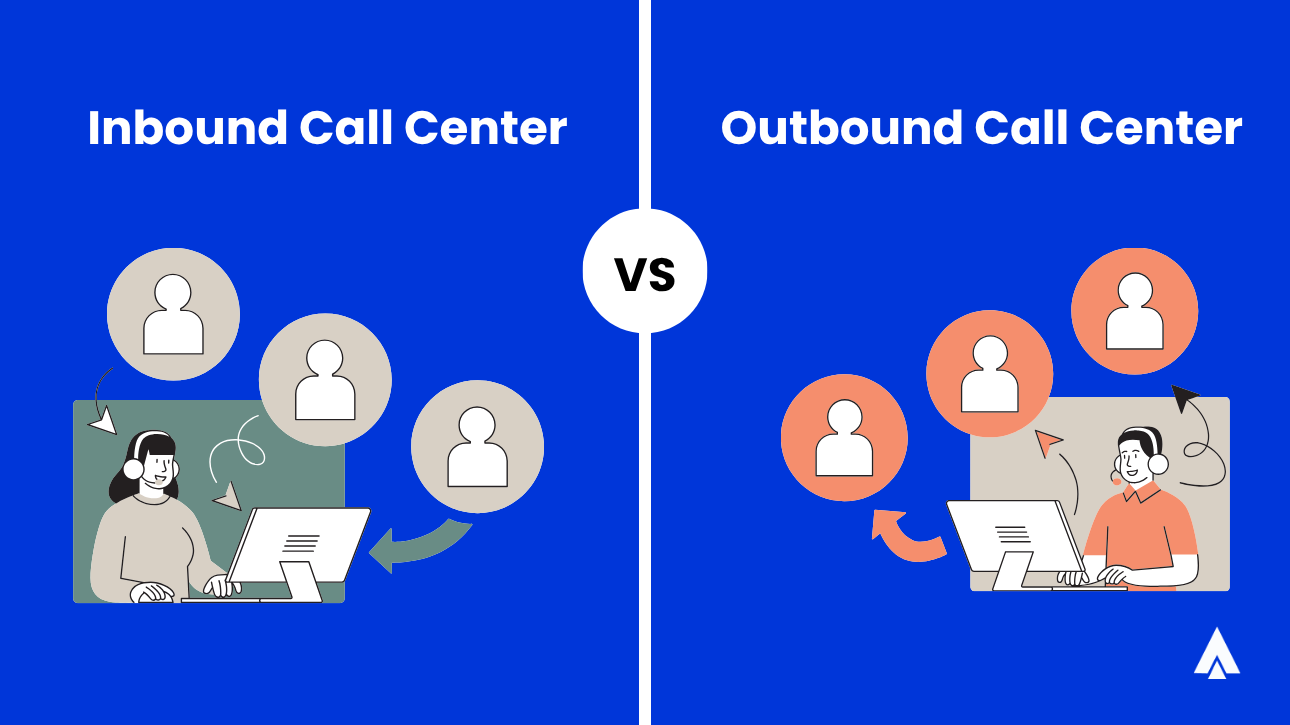You probably recall hearing the term ‘call center’ from before you first heard the term ‘contact center’. We don’t blame you—both are often used interchangeably. However, cloud contact center software not only evolve from call centers, but reimagine customer service and outbound sales.
At their core, call centers deal with customer queries via calls, while contact centers use multiple channels such as voice, text, email, and video to do the same. But there is more to this differentiation than the latter’s ability to go beyond voice calling—in today’s time, customer success can is highly dependent on having a multi-channel presence; in other words, you must be everywhere your customer is.
Hence, with this article, we aim to not only highlight the differences between contact vs call center but also tell you why contact centers are irreplaceable in today’s times, and call centers are—for a lack of a better term—redundant.
First, let’s understand how Contact vs Call Center operates.
What is a Call Center?
Gartner states, “A call center is a group or department where employees receive and make high volumes of telephone calls. They can have internal customers or external customers.” In functional terms, these departments present employees with a help desk and callers with a helpline.
Agents addressing customer queries via incoming calls from an inbound call center, and those engaging with sales activities form an outbound call center, often utilizing an outbound dialing system to streamline their processes. Depending on its size, a call center can be strictly inbound, outbound, or hybrid. A hybrid calls center sees agents attend incoming as well as outgoing calls daily.
Apart from their function, there is another factor that helps classify call centers better—their location.
- In-house Call Center Software
These are on-premises departments where agents sit together with dedicated hardware and software to handle customer calls.
- Virtual Call Centers
Virtual call centers have agents working from remote locations with the help of an internet-enabled device and calling software.
What is a Contact Center?
Cloud contact center, as mentioned above, are the evolved versions of call centers that operate over multiple channels. They also offer many more features and assure high customizability.
They work on the latest VoIP or Voice-over Internet Protocol technology. As the name suggests, VoIP allows you to make calls over the Internet. Learn more about best VoIP systems in this guide.
While calling remains a significant communication platform for customers, contact centers also include other mediums such as SMS, chat, video, and emails, often on a unified platform. This aspect makes contact centers more suitable for customer services. However, you can still use them for sales and technical support. According to Time Doctor, an increasing number of people prefer using multiple channels such as social media, email, calls, and chat to communicate with brands.
Like their predecessors, contact centers can be classified into different groups such as inbound contact center, outbound contact center, hybrid, in-house and virtual.
Despite these centers being feature-rich and technologically advanced, their digital nature makes them cheaper to build and maintain for providers and costs you much less to deploy.
If you want to read more about how call centers evolved into modern-day contact centers, you can find it in ours Complete Guide to Contact Centers and Running Them Successfully.
Contact Center vs Call Center: Key Differences
| Aspect | Call Center | Contact Center |
| Communication | Voice | Omnichannel |
| Approach | Reactive | Proactive |
| Technology | Traditional | Cloud-based |
| Automation | Limited | Advanced |
| Scalability | Fixed | Flexible |
| Data Insights | Basic | Advanced |
| Support | Single channel | Multichannel |
| Infrastructure | On-premises | Cloud-based |
| Reporting | Manual | AI-driven |
| Customer Experience | Standard | Personalized |
Call Center vs Contact Center: Which One to Choose?
Now that we’ve briefly discussed their similarities and history, we can get down to the main agenda of this blog: Are contact centers or call centers better for your business? To identify that, we look at their differences as given below:
1. Narrow vs. in-depth customer data
Due to call centers being restricted to a single channel for customer interaction, the data they gather is limited. They may use speech analysis to understand the customer’s preferences and emotions, but it won’t be enough. Contact centers, however, provide omnichannel support and gather data from multiple platforms for a deeper understanding of the customer’s preferences.
2. Traditional vs VoIP calling
Traditional calling systems, which most call centers deploy, fall behind in providing top-notch calling experiences as compared to VoIP. The traditional system restricts calling to a single device (for instance, a landline), while VoIP calling lets you make calls from any device. All it takes is an active internet connection and a portal login.
Read this blog “VoIP Vs Landline” here.
3. Rigidity in features vs. customizability
Contact centers offer much more customizability than traditional call centers. Traditional communication systems are often limited because any modification requires expensive hardware changes. On the contrary, voip phone system offer many features that you can pick with a single click. For instance, at Acefone you can choose from 65+ customizable features that constantly update and witness additions.
You can also check out those Call center features here.
4. Reactive vs. Proactive Customer Support
Call centers primarily operate reactively, meaning agents only respond when a customer calls in with a query or issue. This limits engagement opportunities and often leads to longer resolution times.
Contact centers, on the other hand, use automated follow-ups, and predictive analytics to engage customers proactively. You can send appointment reminders, follow up on abandoned carts, or notify customers about service upgrades—ensuring a smoother customer experience while reducing inbound call volume.
5. Limited vs. Omnichannel Communication
Call centers focus solely on voice-based interactions, restricting customer communication to phone calls. This can be inconvenient for customers who prefer messaging or digital platforms.
Contact centers provide omnichannel support, allowing customers to interact via email, SMS, live chat, social media, and video calls. This ensures customers can connect through their preferred channel and switch between platforms seamlessly while maintaining a conversation history for a unified experience.
6. Manual vs. Automated Workflows
Traditional call centers rely heavily on manual operations, including call routing, agent assignments, and customer data entry. This can lead to inefficiencies and human errors.
Contact centers automate these processes with smart IVRs, chatbots, and intelligent call distribution. Automated workflows reduce agent workload, speed up resolutions, and enhance customer satisfaction. For instance, chatbots can handle common inquiries 24/7, while smart routing ensures customers connect with the right agent instantly.
7. Basic Reporting vs. Advanced Analytics
Call centers provide basic reports focused on call duration, call volume, and agent performance. While useful, these reports offer limited insights into customer behavior.
Contact centers leverage advanced analytics tools that track sentiment analysis, real-time customer interactions, and engagement patterns across multiple channels. Businesses can use these insights to personalize customer interactions, identify service bottlenecks, and improve overall customer experience.
8. On-Premises vs. Cloud-Based Infrastructure
Most traditional call centers operate on on-premises systems. This means that they require costly infrastructure, dedicated IT teams, and frequent hardware upgrades. This limits scalability and flexibility.
Contact centers are cloud-based, allowing businesses to scale operations effortlessly without investing in expensive hardware. Your team can work remotely with secure access to customer data, ensuring uninterrupted service even during disruptions. Cloud solutions also offer regular software updates, ensuring businesses always have access to the latest communication technologies.
Why are Companies Switching from Call Center to Contact Center?
Drew Kraus, the VP Analyst at Gartner Customer Service & Support, said, “Contact center as a service (CCaaS) is a growth market; The technology offers greater software agility with a tower cost of ownership, making it a key area of investment in innovation and customer service applications that surpasses the offers of legacy premises-based or server technology.”
Recent studies validate this. According to global statistics the Contact Center as a Service (CCaaS) market was valued at approximately USD 5,108.4 million in 2024. Projections indicate that it will expand from USD 5,799.06 million in 2025 to approximately USD 7,473.13 million by 2033, with an estimated compound annual growth rate (CAGR) of 13.52% over the 2025–2033 period.
If you’re still not convinced whether you should use Contact center vs. call center, here are a few benefits that will help you decide.
1. Cost-effective
Contact center solutions come at cost-effective rates compared to call center business pbx systems. To set up a contact center system, the only investment you need is a device and a VoIP-enabled calling solution. You save money on hardware installation, excessive hiring, and infrastructure maintenance.
2. Scalability
Any changes you wish to make to your calling solution can be made with a few clicks. If you need more extensions or user logins, you can simply ask your provider to include them in your subscription. You can add more agents to the system instantly if you experience a rapid increase in your daily calls.
3. Unified view
A key benefit of using a cloud contact center solution is that it gives you access to all data on one platform. The calling portal showcases customer information from multiple channels on one dashboard.
4. Future proof
Google says, “Moving to the cloud is giving organizations of all shapes and sizes the ability to move faster, be more agile, and innovate their businesses.” That’s true for cloud solutions of all sizes—any technological innovation in the cloud telephony space will be a part of your solution sooner rather than later. This way, always rest assured of better automation, productivity, and reliability.
5. Agent productivity
Contact center solutions make it easy for agents to deal with higher call volumes without getting overwhelmed and still provide meaningful solutions. With features such as call recording, call barging, call transferring, and live call monitoring, managers can supervise agents more efficiently and help them reach their goals faster.
Conclusion
While call centers focus on sales, contact centers are the go-to option for overall customer service as they provide better agent assistance and analysis.
Investing in a cloud contact center, however, is a wiser decision for overall productivity. You get an omnichannel solution for smoother communication with access to 75+ customizable and future-proof features. Scaling a contact center solution is also easier as it doesn’t require adding any expensive hardware. You can even add and remove agents from the dashboard with a few clicks. Thus, getting contact centers Are the Future of Call Centers for your business can yield better ROI and later upgrading it.
Frequently Asked Questions
A call center handles only voice-based communication, primarily incoming and outgoing phone calls. A contact center, on the other hand, manages communication across multiple channels such as voice, email, chat, and SMS. This provides a more integrated, omnichannel customer service experience. Call centers are broadly classified into three types: inbound, outbound, and blended. Inbound centers handle incoming customer calls, like support or inquiries. Outbound centers make calls for sales, surveys, or collections. Blended or hybrid centers (like Acefone’s contact center studio) manage both incoming and outgoing calls for greater flexibility and efficiency. Contact centers can be classified into on-premise, cloud-based, and hybrid. On-premise centers are hosted in-house with physical infrastructure. Cloud-based centers operate virtually using internet-based platforms. Hybrid contact centers combine both setups, allowing businesses to scale and adapt while leveraging existing infrastructure and cloud flexibility. A contact center is generally better if you need omnichannel support, offering voice, email, chat, and SMS. Call centers are ideal for voice-only interactions. The choice depends on your customers’ preferences, teams’ needs, and communication strategy. Contact centers offer more flexibility, while call centers are simpler and voice-focused. Yes, contact centers include call centers as part of their services. While call centers focus solely on voice calls, contact centers consist of voice and additional channels like chat, SMS, and email. Essentially, every contact center offers call center capabilities, but not all call centers function as contact centers. Modern contact centers use cloud telephony, AI-driven IVRs, CRM integrations, omnichannel routing, real-time analytics, and workforce management tools. These technologies streamline customer interactions, automate repetitive tasks, and enable agents to deliver personalized support. Cloud infrastructure also ensures scalability, remote accessibility, and reduced hardware dependency for operational efficiency. Industries with high customer engagement like BFSI, retail, professional services, education, and healthcare benefit most from contact centers. These sectors need fast, multichannel communication, and personalized support. Contact centers help streamline interactions, improve customer experience, and boost retention by managing diverse communication touchpoints efficiently across the customer journey. Call centers offer direct, personal interaction, but can be limited to one channel. Contact centers improve customer experience by enabling your customers to reach you via their preferred channels like voice, chat, email, or SMS. This ensures faster resolutions, seamless interactions, and consistent support across all communication platforms.














